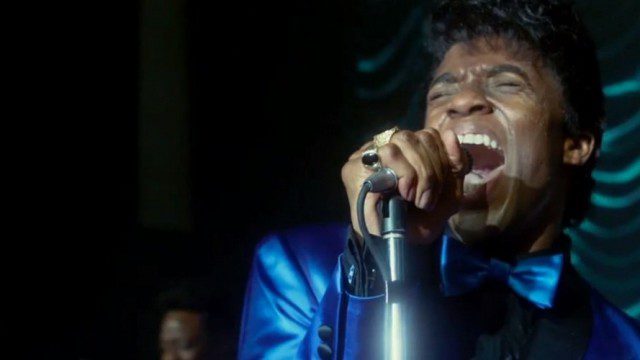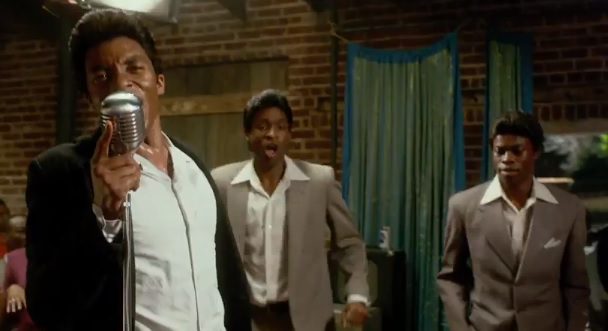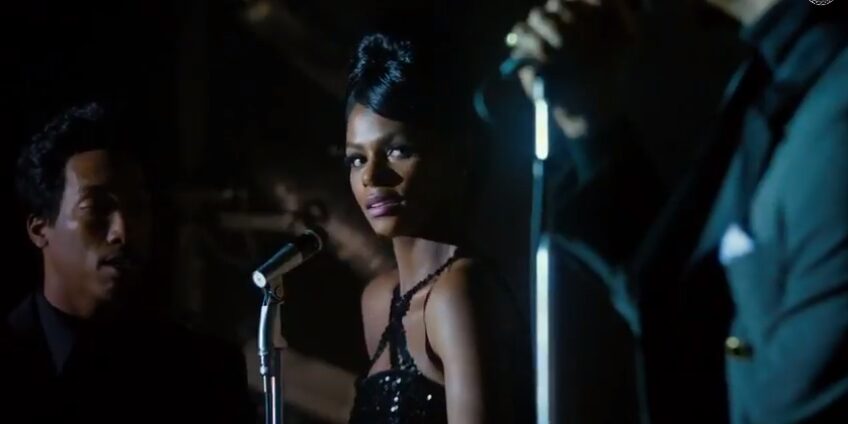There are two types of people in the world: those who love James Brown and those who never cared much for music in the first place. The singer who earned the title “The Hardest Working Man in Show Business” legitimately was one of the few artists-like The Beatles, Bob Dylan, and Chuck Berry-whose work touched in some way every record you own—(just try to imagine hip-hop happening without samples of his groove and inimitable scream). By the late 60s he made the transition from R&B to funk, pioneering a hard new sound that was defiantly his own while never once pandering to white audiences along the way. The most essential concert album ever is, more than fifty years after its release, still his (Live at the Apollo, 1962). His output was staggering; the life he led offstage colorful, controversial.
There’s a great story to be told here about an American icon. Get On Up by director Tate Taylor (he of Pretty Ugly People and The Help) threatens to be it, and at times is exactly what it needs to be, but doesn’t all add up. It’s at once unlike and exactly like every biopic you’ve seen; the treatment is crowd-pleasing Ray with a weird touch of the Todd Haynes dream-kaleidoscope Dylan puzzle I’m Not There. What’s most disappointing though is that it nevertheless plays right into the hands of cynics who dismiss movies like it on sight. There is juice in the biopic format. And Get On Up occasionally proves it.
Taylor starts things off scrappier and stranger than you’d expect. After a yawningly predictable opening of the singer making his way to the stage to cheers from the crowd and some in his head (it serves as the movie’s tired bookends), things quickly change up. The year is 1988 in Augusta, Georgia, and James Brown (played by Chadwick Boseman) is not in his right mind. He pops up at a business he owns, surprising the people inside. When nobody will admit to using his toilet, he retrieves a shotgun and lectures the all-white middle class folks there about what’s his and what’s right, before accidentally firing at the ceiling. The scene is definitely nutty, yet you can’t help but admire the audacity of starting things with a spat over toilet privileges.
From there it’s a twisty, episodic biography that freely jumps back and forth between decades but is armed with snappy captions to announce which year you’re in (“1949: Music Box”, “1955 Mr. Please Please Please”, and so on). In one cartoonish scene you’re watching James Brown and his group nearly shot down on their helicopter ride through jungles of Vietnam. In another he meets Little Richard (a terrific scene between two young icons on the cusp of fame and fortune). Most critically it maps out the origins: James Brown as a boy in the Depression era woods of Georgia. His father is an abusive derelict; his mother (a too brief part from the wonderful Viola Davis) seems loving at first but ultimately scorns young James by leaving him behind. Isn’t long before he winds up with his aunt (she’s Octavia Spencer) who raises him until the time he’s 17 which is when he gets busted for stealing a suit (the deep South police fire at him and call him “boy”). He only gets out because of another young man jailed there named Bobby Byrd, whose parents let him stay at their place.
Chadwick Boseman’s cocky and energetic performance, whether as teenaged Brown or the old nearly self-caricature of a man he eventually became is nothing short of extraordinary. This is flat-out great work and Boseman-already something a name for an acclaimed breakout as Jackie Robinson in 42-could be on the verge of becoming a major star. It’s acting of unbelievably studied and accurate impersonation: he doesn’t just approximate the aggressive way James Brown carried himself or the raspy voice, he even nails the way he moved his mouth. And yet it’s a lot more than that: he makes his every word and movement an expression of pure confidence and sexuality. He nails the dance moves and the more overtly emotional, serious scenes. When he declares that the crowd better be ready for him (“especially the white folks”) the part is so spot on he nearly threatens to displace the image of the actual James Brown in your head for a minute.
Get On Up reminds you as starkly as Ray did just how bold much of this now classic music was to fresh ears. In one amusing scene a record industry square listens to Brown and Byrd (at that point still The Famous Flames) play “Please Please Please” thoroughly confused and annoyed. “Please what? Where’s the chorus? What’s the hook?” he demands. Later as Brown’s music shifts from more conventional R & B/soul to proto-funk, his musicians can hardly process his instructions of where to place the beats, it seems that unorthodox and wrong at first. The hook of Get On Up-and what Boseman seems to intuitively realize in his depiction-is how much the music and the offstage behavior and business conduct were expressions of the same need for autonomy and self-determination. The sound was his baby. So was the business—which is why he financed and organized the classic Apollo show and undercut the established middlemen promoters where he could. No one would get in his way.
That didn’t always make him the most pleasant person in the world. Brown isn’t let off the hook by screenwriting brothers Jez and John-Henry Butteworth for that. He was a jerk to the men he worked with, screwing The Famous Flames by stamping his new on the group without their consent then making them paid employees. Mistakes were punished by him confiscating a musician’s pocket cash and as for proper days off, forget it. Worst of all, his insatiable appetite for women didn’t preclude hitting them. Taylor only shows this happen once. It comes out of nowhere and jolts his wife as much as the audience (singer Jill Scott as Deidre “Deedee” Jenkins). Later we see more of Brown’s abusive, jealous side and the inexplicable way the two were able to reconcile his worst impulses and their marriage, at least for a while. The point is neither belabored nor papered over.
Get On Up can feel unusual and intriguing in parts and shockingly safe and bland in others. A couple times Brown breaks the fourth wall, explaining significant aspects of his story directly to the camera (“Ya get my point, right?”). In another, little boy James Brown symbolically replaces the adult one. When he notices at a taping just how exclusively white and preppy the audience is, the camera slows and joins in his commentary on the absurdity of it. The flashback to young James boxing blindfolded for the entertainment of white good old boys is telling, yet really weird. Scenes jump, they interlock.
Elsewhere it plays less like free form jazz, and more like comfort food tunes. The scene where his mother returns the better part of thirty years later feels like so many you’ve seen before. The way the working relationship with Byrd (played by Nelsan Ellis) dissolves too feels familiar. Even the reenactments of his live concerts eventually feel like punchy, enjoyable filler—and at 138 minutes, the movie does not suffer for lack of running time. Boseman’s electrifying performance holds it all together more than anything else. There’s a much clearer idea from the filmmakers of what to say about James Brown than how exactly to say it. What’s there makes for a peculiarly assembled and vaguely unsatisfying movie. Get On Up has the notes, the beat, the timeless recordings of a legend, and even the spirit, but no hummable melody of its own.



